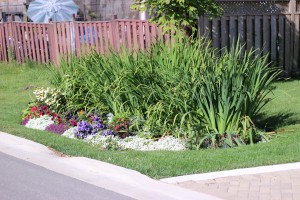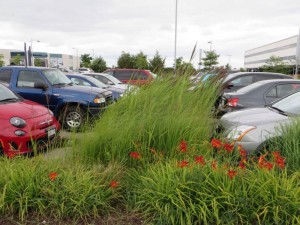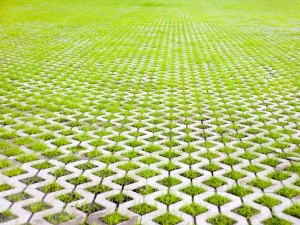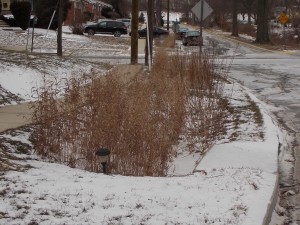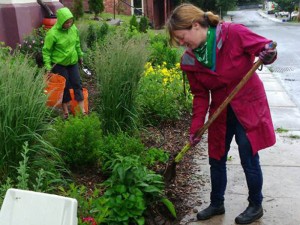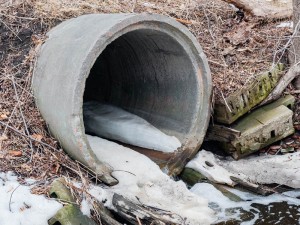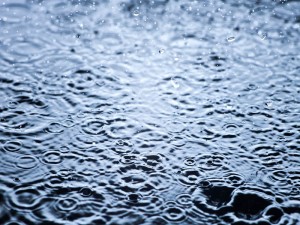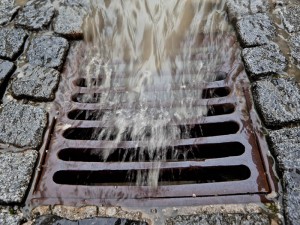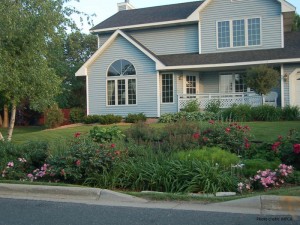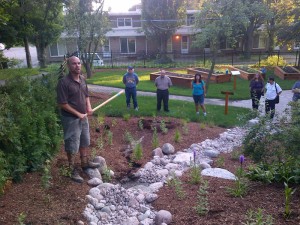Want to know more about green infrastructure?
Here are some of the most frequently asked questions.
Green stormwater infrastructure is a new concept for many communities. Our goal is to share information and clear up misconceptions about this technology. Contact us if your question isn’t answered below.
What is green infrastructure?
Green infrastructure, also known as Low Impact Development (LID) is a method for managing urban rainfall which imitates the natural hydrological cycle by managing rain close to where it falls and capturing it, infiltrating it through soils, or evaporating it. Practices include rain gardens (bioretention), bioswales, permeable paving, green roofs, urban trees, and infiltration galleries. Check out Rooftops to Rivers by the Natural Resources Defense Council for a good overview of green infrastructure and how it is being used by cities.
Is green infrastructure more expensive?
Many case studies show that green infrastructure is cheaper than conventional grey infrastructure, both in capital and maintenance costs. The USEPA estimates costs savings of 15%-80%. Savings can come in the form of reduced lifecycle costs, reduced need for expensive grey infrastructure (curbs, gutters, and ponds), and reduced land requirements. At the same time, green infrastructure offers additional economic benefits like flood-reduction, reduced liability for slips and falls, reduced need for road salt, fewer days of closed beaches, and lower water and energy bills. Philadelphia is saving an estimated $5.6 billion dollars over 25 years by investing in green infrastructure instead of only grey.
Can we count on it?
Green infrastructure has been built, implemented, and tested all over Canada and the U.S. Big cities like Philadelphia, Milwaukee, New York, Washington D.C. and Seattle are relying on green infrastructure for significant portions of their stormwater management. Monitoring results from studies in the U.S. and Canada show that green infrastructure is able to capture beyond 90% of runoff from regular storm events, reduce pollutant loads by over 90%, and reduce volumes and delay peak flows during extreme events. See theBurnsville rain garden study from Minnesota, an overview of monitoring results from Credit Valley Conservation, and a number of studies from the Sustainable Technologies Evaluation Program.
We have winter. Will it still work?
Green infrastructure has been tested in Canadian winters. Studies at the Sustainable Technology Evaluation Program and the University of Calgary have shown that all types of permeable paving perform well in winter. There is no evidence for increased damage from frost heave for permeable pavement compared with regular pavement, due to the lack of standing water and associated freeze-thaw cycles. Green infrastructure measures reduce icing hazards by infiltrating water and avoiding surface pooling. Many cities which experience harsh winters (Milwaukee, Philadelphia, New York) have had success with green infrastructure. Minnesota, a northern cold climate state (north of Toronto) has been an early adopter of green infrastructure with great results.
What about maintenance?
Green stormwater infrastructure maintenance may include vacuuming of permeable pavement, clearing debris from inlets for rain gardens and bioswales, and weeding. Bioretention may require sediment removal from the soil medium and replanting. Activities like weeding and litter collection can be done with regular landscaping maintenance (of boulevard gardens, etc.). Community engagement programs have been successful in getting volunteers perform basic maintenance of rain gardens and bioswales. Maintenance costs are relatively low, when compared with the costs of dredging stormwater ponds (estimated to be at least $260,000 for a single pond).
Is it safe for groundwater?
Directing clean roof runoff to cisterns, rain gardens, bioswales, or infiltration galleries does not pose a risk to groundwater. Pretreatment can help reduce risks from more contaminated runoff, like from roads and parking lots. Stormwater pond performance varies in contaminant removal, with performance deteriorating if maintenance is not performed regularly. Green infrastructure generally has much higher rates of pollutant removal than ponds. Road salt, which is not treated adequately by green infrastructure practices, is also not removed by stormwater ponds. The first priority for protecting all waters is pollution prevention – taking action to reduce, eliminate and contain potential contaminants.
Will green infrastructure work in extreme weather events?
Green infrastructure on a community-wide scale helps make cities more resilient. Capturing and infiltrating the first inch of rainfall helps delay peak flows during extreme events, allowing existing grey stormwater infrastructure to work more effectively. The Elm Drive road rain garden retrofit in Mississauga delayed peak flows during the 8 July 2013 storm by 40 minutes. Climate change can increase volumes in mid-intensity events, not only extreme events, and green infrastructure can greatly reduce or eliminate runoff from these events. Studies have shown that green infrastructure reduces average losses from flood events, even in areas with low infiltration soils.
This is new technology. Why take the risk?
According to the Ontario government: “Conventional (pipe and pond) stormwater management practices that focus on controlling peak flow rate and removal of total suspended solids are not fully achieving the desired protection of the watershed ecosystem.” The Ontario government has consistently reiterated its requirement for the use of green infrastructure, in both new development and in retrofits. In many cities, stormwater infrastructure is reaching the end of its lifespan and will require upgrading at significant cost. Green infrastructure offers cost savings and performance benefits. Communities are experiencing increased extreme weather events due to climate change. Green infrastructure solutions are more flexible than grey and can be constructed quickly and relatively easily, while grey solutions cost millions and take years to implement.
Will developers actually do this?
Developers are interested in maximizing the profit available from their lands. Some developers are finding that green infrastructure frees up more land than traditional methods of storm water management, making the decision to install green infrastructure an easy financial choice. In addition, attractive rain gardens have been found to be selling features on residential properties. Municipalities and conservation authorities can implement measures that make green infrastructure even more attractive to developers. In the Lake Simcoe area, developers are able to meet with the municipality and the permitting body to consult on the incorporation of green infrastructure into development plans. The meeting and the pre-design consultation save the developers time and money, and have resulted in increased adoption of green infrastructure.
How does it work on private property?
Managing rain close to where it falls requires a decentralized approach, which often necessitates the installation of green infrastructure on private property. This is quite different from traditional stormwater management and can make stormwater managers nervous. However, with community consultation and engagement, there have been many successes with the installation and maintenance of green infrastructure on private property. There are different approaches including education and assistance programs,grants and rebates, or credits on stormwater utility charges. Some cities require property owners to sign maintenance agreements and allow periodic inspections of the green infrastructure in order to qualify for grants or incentives.
What is green infrastructure?
Green infrastructure, also known as Low Impact Development (LID) is a method for managing urban rainfall which imitates the natural hydrological cycle by managing rain close to where it falls and capturing it, infiltrating it through soils, or evaporating it. Practices include rain gardens (bioretention), bioswales, permeable paving, green roofs, urban trees, and infiltration galleries. Check out Rooftops to Rivers by the Natural Resources Defense Council for a good overview of green infrastructure and how it is being used by cities.

